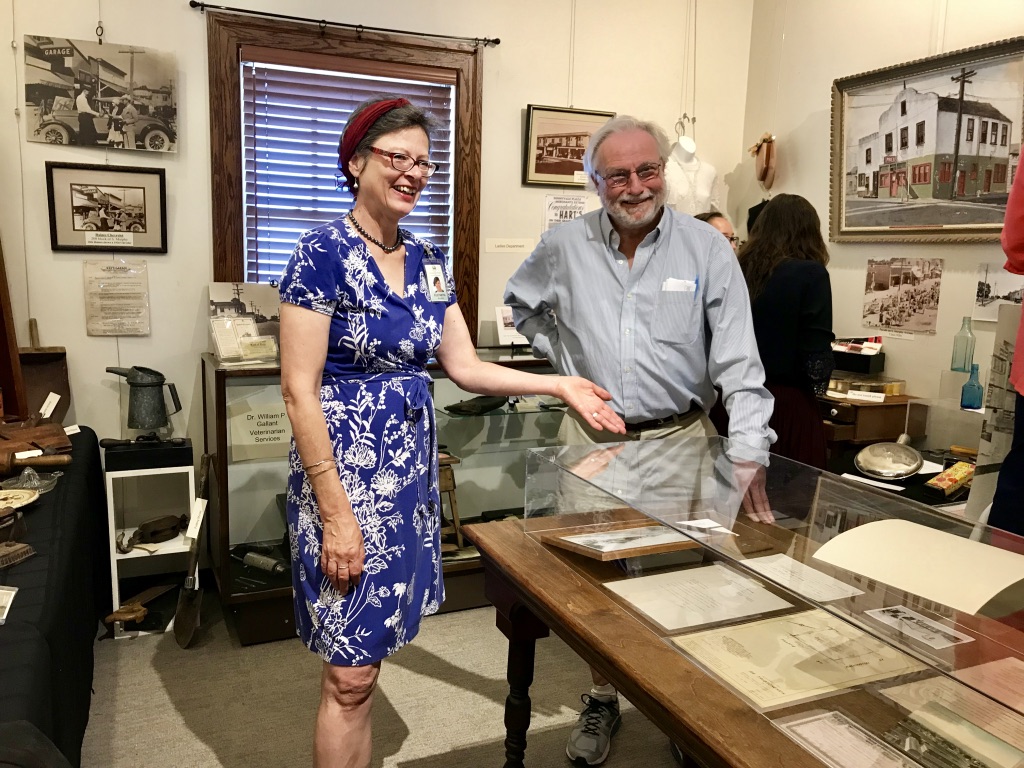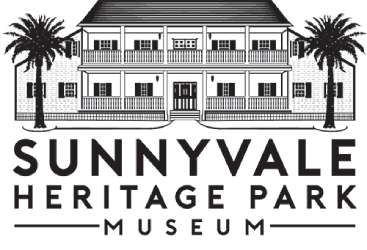Volunteer as a Museum Docent and Discover Rewarding Benefits
The Sunnyvale Historical Society and Museum Association is looking for volunteers for our docent program. In an effort to educate the public on the docent experience, we are providing our readers with specific information to help people decide if this is something they can do.
Our docents greet visitors of all ages to the Heritage Park Museum. They lead tours, share information, and engage with visitors through our outstanding museum collection and exhibitions to enhance the lives and experiences of students and residents in Sunnyvale and surrounding communities.

Though docents don’t dress in costumes to work at the museum, some chose to do so for the special occasion of our recent anniversary event.
Dina Bensen, docent coordinator at the Heritage Park Museum, says that joining a docent program offers many unique benefits. “This is a very special place to spend time with everyone who enters to share Sunnyvale’s history and the Murphy family’s role in the beginnings of this city. There are so many interesting displays to see and people leave with a definite sense of place that they didn’t have before. Being a docent is a wonderful way to learn more about the amazing development of this area, to impart that information to visitors, and to make a difference.”
Karen Kenton, another volunteer docent, says the educational aspect of the job is beyond compare. “As a history buff, I love to share the Murphy family story and their unique contribution to the early stages in the state of California. Engaging our visitors in the stories our beautiful museum has to tell is a fun way to spend an afternoon. It’s a friendly and rewarding experience to be a docent and a valuable way to use your volunteer time. The many visitors who share their own family stories make the Sunnyvale Historical Museum a happy place.”
In addition to learning, being part of a docent program creates a community. Docent Christel Fliss says, “to be a docent at the museum has been gratifying in many ways. It gives me a chance to share Sunnyvale’s unique history, especially the fascinating story of the Murphy family with visitors from near and far. I always enjoy our foreign visitors and value the camaraderie and conversations with other museum docents, often learning even more about Sunnyvale’s past.
Receive Free Training
The SHSMA is looking for volunteers who are open minded and ready to learn new things. The docent coordinator has a training program in place, which involves training sessions before a new docent begins to lead tours. These sessions are designed to teach volunteers the role, as well as prepare them to be comfortable providing information to visitors. “Our museum offers easily followed personal training,” says docent coordinator Dina. “After that, a hands-on approach allows an opportunity to first shadow other docents’ tours, next, co-lead, and last, when you are comfortable, conduct your own tour.”
Completing a docent training program at the museum can help a volunteer develop keen observation skills and greatly increase their knowledge of history. Training includes familiarizing oneself with the museum’s exhibits, acquiring a deeper knowledge of Bay Area history, as well as presentation techniques, and how to use interactive education. “Time commitments vary greatly,” says Dina. “Some volunteers can commit to only one afternoon, consisting of four hours a month, while others often do two days a month or more. We do not have any specific protocol. Some of our volunteers give 400 hours a year, while others give 50. Both are of great value to us!”
The duties of a docent
- Arrive ten minutes before opening time at 12:00pm, and switch on all the lights in the exhibit rooms.
- Make sure there are pens for visitors to sign the guest book.
- Welcome visitors as they enter.
- Ask if visitors would either like a tour, or would prefer to walk through on their own.
- Introduce the short, six-minute video that gives them a summary of the successful first wagon train across the Sierra Nevada.
- If visitors decide to do a self-guided walk-through, check in periodically to see if they have any questions.
- Ask visitors to please sign the guest book.
- Thank them for their visit.
- At closing time, turn off all the lights (check the bathrooms to see if anyone is still in there), close sliding doors, and move the cash donation box into the introduction room.
There are always two docents scheduled at one time. During opening hours, the Museum Store is open and staffed with volunteers to assist shoppers. It is always a good idea to direct visitors to the range of books we have on Sunnyvale and California history.
Q and A with Katharina, an experienced docent:
How long do you have to train for?
Everyone’s speed is different depending on how you learn information. It’s all in your own hands, you will not be scheduled as a docent until you think you are ready. The length of your training is guided by your comfort level.
As a docent in training you will receive:
- Materials you can read on your own. – We give docents-in-training a copy of the California trail booklet to get a summary of the Murphys’ journey across the country. It has a bibliography, so you can look up other books to gain more information (all of which are, of course, in our museum library).
- An initial tour through the exhibits for you to pick up the general story line. – Every docent has a different way to present what we have, and everyone has different strengths.
You will gain a lot of detailed knowledge by reading the panels in the exhibit rooms.
I always recommend to people shadowing a morning in the school program, because most of the material is presented there. The school program runs from January to May, every Monday, Wednesday and Friday morning from 9:00 to noon.
Shadowing more than one docent is so helpful. You learn a lot from the different styles.
Is it a challenge to remember everything you’re supposed to know?
This depends on your interest levels. Yes and no. Everyone retains information differently. I tend to concentrate on the human stories but forget about the family tree, for instance. There are lots of materials at the docents’ desk to quickly look something up, or even to take with you for reference on the tour. One of our docents created a “quick guide” with laminated cards that’s very handy. – You’re learning ALL the time.
Do you shadow other docents when you are learning?
Absolutely. As much as possible.
How soon do you start being a docent on your own?
When YOU feel you’re ready. – There are always two of you, so if you get stuck, you can turn to your fellow docent or direct the visitor to the panels for them to read in a particular room.
What if someone asks you a question you don’t know the answer to?
This happens all the time. Just know where to find the information: docent desk, ring binders, workroom books. Often, it’s quickest to just stick your head into the workroom and ask the people there…. Visitors will sometimes ask out-of-the-way questions, don’t feel bad if you don’t have the answer. Just try your best to find the answer.
If volunteering to be a docent is something that interests you, contact us to set up a time to come to the museum and speak to the program director.


